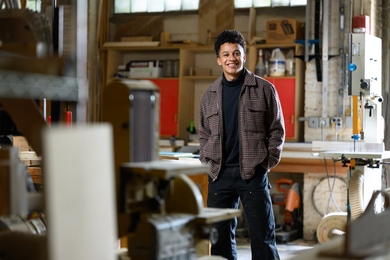Tim Berners-Lee, director of the World Wide Web Consortium (W3C) at the Laboratory for Computer Science (LCS) and the father of the World Wide Web, has won a $270,000 MacArthur Fellowship.
MIT alumnus Karl Sims was also among 29 Fellows announced last week by the John D. and Catherine T. MacArthur Foundation in Chicago. Mr. Sims will receive $235,000.
The winners of the "genius awards" receive $220,000 to $375,000 over five years, depending on the age of the recipient. The Fellowships, awarded annually since 1981, are unrestricted grants to individuals, not projects or organizations.
Mr. Berners-Lee joins an elite group of MacArthur winners from MIT. Others are Professors Jed Z. Buchwald, Noam Chomsky, Evelyn Fox-Keller, John H. Harbison, Michhael Kremer, Eric S. Lander, Heather N. Lechtman, Richard C. Mulligan, David C. Page, Michael J. Piore, Charles F. Sabel, Richard Stallman, Alar Toomre and Jack Wisdom.
Along with conceiving and developing the World Wide Web in 1989-90, Mr. Berners-Lee designed the uniform resource locator (URL) protocol, a common system for referring to documents and multimedia recordings on remote computers, and established the first web server on the Internet.
In his role as director of W3C, a nonprofit, member-sponsored organization, he encourages the development of open communication specifications. Mr. Berners-Lee, 43, is now working to enhance the capacity of the web as a mode of free expression and global collaboration.
Born in London, Mr. Berners-Lee earned the BA in physics in 1976 from Queen's College at the University of Oxford. He joined LCS in 1994 and received the Kilby Foundation's Young Innovator of the Year award the following year.
Mr. Sims was born in Boston. He received the SB in biology in 1984, and in 1987 earned both the SM in architecture and the SM in media arts and sciences.
He is a computer scientist and pioneer in the field of computational evolution, who uses genetic algorithms to obtain new solutions to tangible problems, develops graphic representations of those solutions, and then uses those graphics to teach the principles of biological selection. He is self-employed.
Some of his software presents physics-based, simulated worlds that demonstrate how evolutionary processes can lead to novel and unexpected solutions. Mr. Sims's recent interactive installation, Galapagos (on permanent exhibit at the Intercommunications Center, an electronic arts museum in Tokyo), allows viewers to apply aesthetic criteria to animated figures, determining which survive to reproduce--a demonstration akin to nature's mechanism of sexual selection.
The MacArthur Foundation does not require or expect specific products or reports from its Fellows. This year's recipients cover a wide range of interests, ranging from cosmology to cattle ranching, from literature, theater, art and poetry to religion, astrophysics and biochemistry. There's even a lawyer and a journalist among them.
The foundation invites up to 125 people to serve anonymously as nominators, or "talent scouts," each year. Individuals may not apply for MacArthur Fellowships. Nominators are selected for expertise in their fields and the ability to identify exceptional creativity.
The nominations are evaluated by a 12-member selection committee, which also serves anonymously and makes recommendations to the foundation's board of directors, which makes the final decision. Typically, 20 to 30 Fellows are selected each year.
Including the 1998 winners, a total of 531 Fellows have been named since the program began in 1981, ranging in age from 18 to 82. The MacArthur Foundation, a private, independent grantmaking institution with $4 billion in assets, has invested more than $166 million in the Fellows Program.
A version of this article appeared in MIT Tech Talk on June 3, 1998.





